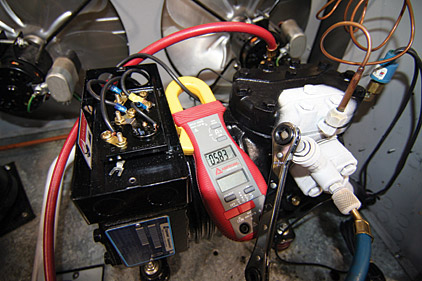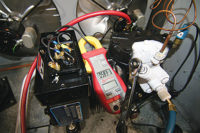
|
| Fig. 1. Frost coming back to an air-cooled compressor. Evaporator has more than nine degrees of superheat. Compressor has more than 25 degrees of total superheat. (Photo courtesy Ferris State University) |
Many service technicians believe that frost on a suction line or on the compressor’s head itself indicates there is liquid refrigerant coming back to the compressor. This simply is not true.
All frost means is that the suction line or compressor is below freezing, and the moisture in the air has reached its dew point temperature and condensed. This condensed moisture has then froze to ice because of the temperature being below 32° F.
Fig. 1 shows frost coming back to an air-cooled compressor. In this photo, the evaporators had over 9° of superheat and the compressor has over 25° of total superheat. The amperage draw is also normal when compared to nameplate amperage.
Compressor superheat, or sometimes referred to as total superheat, is assurance that there is no liquid refrigerant present at the compressor and that the saturated vapor in the evaporator has gained 25° of sensible heat before reaching the compressor. The condensing unit was a low temperature application running –10° box temperatures. With –10° box temperatures, the evaporating temperatures averaged about –24°. With –24° evaporating temperatures and the system having 25° of compressor (total) superheat, the compressor return gas temperatures was about 1°. (Equation 1.) Dew (condensed water vapor) will freeze at this temperature (1°) and become frost on the lines and compressor’s head.
Equation #1
Evaporator temperature -24°F + Compressor superheat 25°F
= Compressor in Temperature 1°F
It is important for service technicians to understand the difference between suction gas-cooled and air-cooled compressors. In an air-cooled compressor, the suction return gas does not pass over the windings of the compressor. The return gas simply enters the compressor through the suction service valve on the side of the compressor. This gas enters the suction valve and cylinders right away without seeing any other heat source. If there is any liquid (refrigerant or oil) entrained in this suction gas, the valves and/or pistons/rods themselves can be seriously damaged.
This is not the case for refrigerant gas-cooled compressors. Liquid refrigerant coming back to the compressor must first pass around or through the motor windings. There is a good chance that the windings will be producing enough heat to vaporize any liquid refrigerant before it is sucked up through the suction cavities to the valve structures. Any refrigerant must travel in close proximity to the motor windings before it flows uphill and enters the valve structures and cylinders of the compressor.
The only sure way a service technician can tell if liquid refrigerant is coming back to the compressor (floodback) is to measure the compressor superheat at the compressor. Do not rely on a frost pattern on the compressor because it is not a reliable method. This can be accomplished by taking the evaporating pressure with a gauge set and converting it to a temperature with a pressure/temperature chart. Next, with a thermometer or thermistor, measure the compressor in temperature on the suction line about 6 inches from the compressor. The compressor in temperature should always be warmer than the evaporating temperature. If it is at the same temperature or colder, liquid refrigerant is probably present at the compressor. To figure compressor superheat, subtract the evaporating temperature from the compressor in temperature. The equation is: Compressor in Temperature minus Evaporating Temperature equals Compressor Superheat.
Publication date: 9/3/2012










